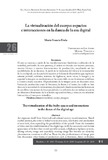| dc.rights.license | http://creativecommons.org/licenses/by-nc-sa/3.0/ve/ | es_VE |
| dc.contributor.author | Unda, María Francia | |
| dc.date.accessioned | 2019-11-05T18:02:58Z | |
| dc.date.available | 2019-11-05T18:02:58Z | |
| dc.date.issued | 2019-11 | |
| dc.identifier.issn | 1315-8392 | |
| dc.identifier.uri | http://www.saber.ula.ve/handle/123456789/46188 | |
| dc.description.abstract | El arte se expresa a partir de las transformaciones históricas y culturales de la
sociedad, partiendo de esta premisa, el artista se vincula con nuevos procesos,
nuevas formas y nuevos instrumentos de producción, ampliando así las
posibilidades de su discurso. A partir de la invención del video y la instauración
de la era digital, con la aparición sucesiva y violenta de dispositivos que registran:
cámara portátil, celulares, sistemas de vigilancia, entre otros; la imagen y en
especial la imagen en movimiento se ha convertido en un fenómeno cotidiano
y común a todos nosotros. El predominio de la imagen pone en discusión otras
formas de producción como la literatura, la danza o el teatro, las cuales se han
visto en la necesidad de reinventarse, desplazando fundamentalmente la manera
de percibir e interactuar de los espectadores. La reflexión de este trabajo se centra
en observar el fenómeno de la relación espectador/obra, y cómo en esa relación/
interacción, el cuerpo se virtualiza. | es_VE |
| dc.language.iso | es | es_VE |
| dc.publisher | SaberULA | es_VE |
| dc.rights | info:eu-repo/semantics/openAccess | es_VE |
| dc.subject | Virtualidad | es_VE |
| dc.subject | Cuerpo | es_VE |
| dc.subject | Imagen | es_VE |
| dc.title | La virtualización del cuerpo: espacios e interacciones en la danza de la era digital | es_VE |
| dc.title.alternative | The virtualization of the body: spaces and interactions in the dance of the digital age | es_VE |
| dc.type | info:eu-repo/semantics/article | es_VE |
| dcterms.dateAccepted | 28- 09- 2018 | |
| dcterms.dateSubmitted | 4- 05- 2018 | |
| dc.description.abstract1 | Art expresses itself from historical and cultural society transformations. Based
on this premise, the artist is linked to new processes, new forms and production
of new tools, thus expanding the possibilities of the speech. From the invention
of video and the establishment of the digital age, with the successive and violent
appearance of devices that record: portable camera, cell phones, vigilance systems,
among others; image and especially moving image has become an everyday
phenomenon common to all of us. There for, the predominance of image puts
into discussion other forms of production such as literature, dance or theater,
which have seen the need to reinvent themselves, fundamentally displacing the
way viewers perceive and interact. The reflection of this work focuses on observing
the phenomenon of the relation, spectator/play, and how the body is virtualized
in that relation/interaction. | es_VE |
| dc.description.colacion | 33-39 | es_VE |
| dc.description.email | undafrancia@gmail.com | es_VE |
| dc.description.frecuencia | Anual | |
| dc.identifier.depositolegal | PP89-0023 | |
| dc.identifier.edepositolegal | PPI2012ME4041 | |
| dc.publisher.pais | Venezuela | es_VE |
| dc.subject.dependencia | Maestría en Literatura Iberoamericana | es_VE |
| dc.subject.facultad | Facultad de Humanidades y Educación | es_VE |
| dc.subject.institucion | Universidad de Los Andes | es_VE |
| dc.subject.institucion | Universidad de Los Andes | es_VE |
| dc.subject.keywords | Virtuality | es_VE |
| dc.subject.keywords | Body | es_VE |
| dc.subject.keywords | Image | es_VE |
| dc.subject.publicacionelectronica | Voz y Escritura. Revista de Estudios Literarios | |
| dc.subject.seccion | Revista Voz y Escritura: Artículos | es_VE |
| dc.subject.thematiccategory | Artes y Humanidades | es_VE |
| dc.subject.tipo | Revistas | es_VE |
| dc.type.media | Texto | es_VE |


